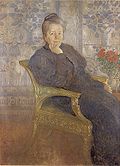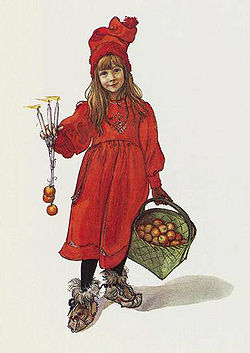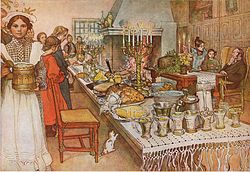Carl Larsson





Carl Olof Larsson (* 28. Mai 1853 in Stockholm; † 22. Januar 1919 in Falun) war ein schwedischer Künstler.
Seine Gemälde, Aquarelle und Zeichnungen zeigen überwiegend das Leben seiner Familie (gemeinsam mit seiner Frau Karin hatte Larsson acht Kinder) in und um das Wohnhaus in Sundborn, Schweden. Carl und Karin gelten als Begründer des heute als „typisch schwedisch“ geltenden Wohnstils, dessen wesentliche Elemente Helligkeit, Farbigkeit und lebendig-fröhliche Funktionalität sind. Das Haus ist heute ein Museum. In Deutschland wurde Larsson ab 1909 berühmt durch sein Buch Das Haus in der Sonne.
Er wird zum Arts and Crafts Movement gezählt.[1]
Leben und Werk
Carl Larsson wuchs in armen Verhältnissen auf. Als er 13 Jahre alt war, ermunterte ihn sein Lehrer zu einem Studium an der Königlichen Kunstakademie in Stockholm. Für die Bezahlung des Studiums war er gezwungen, nebenbei zu arbeiten. So war er zum Beispiel als Retuscheur für einen Fotografen tätig. Nachdem ihm 1876 eine königliche Medaille verliehen worden war, ging es ihm finanziell etwas besser.
Im Jahre 1877 konnte Larsson seine erste Reise nach Paris antreten. Seine dritte Frankreich-Reise führte 1882 in die Künstlerkolonie Grez-sur-Loing nahe Fontainebleau, wo er zahlreiche Aquarelle der umliegenden Natur anfertigte. Hier lernte er auch Karin Bergöö kennen, die wenig später seine Frau wurde. Das Paar kehrte für die Hochzeit nach Schweden zurück. „Dies war ein Wendepunkt in Larssons Leben. In Grez, Larsson malte einige der wichtigsten seiner Werke, jetzt aber in Wasserfarben, und sehr unterschiedlich zu der Ölfarbentechnik, die er vorher benutzte“, heißt es in dem von Michael Snodin und Elisabeth Stavenow-Hidemark herausgegebenen Buch Carl und Karin Larsson – Ihr Leben und ihre Kunst.
Zwischen 1885 und 1888 malte Larsson hauptsächlich Ansichten von Stockholm. Er schloss sich der Künstlergruppe Opponenterna an, die bei der Kunstakademie eine Reform der Kunstausbildung forderte. Diese Forderungen wurden jedoch abgewiesen. 1886 wurde Larsson zusätzlich Vorsteher einer Kunstschule in Göteborg.
1888 bekam die Familie ein kleines Haus nahe Sundborn von Larssons Schwiegereltern geschenkt. Das Haus wurde nach und nach handwerklich wie künstlerisch von Carl und Karin ausgebaut, ausgeschmückt und erweitert und wurde unter dem Namen „Lilla Hyttnäs“ (etwa: kleine Hütte) bekannt. Das Haus wurde künstlerischer Mittelpunkt Larssons, die sieben Kinder des Ehepaares (ein achtes starb kurz nach der Geburt) wurden hier großgezogen und, in einzelnen Werken zusammen mit der Dorfgemeinschaft, auf zahlreichen für Larsson typischen Ölgemälden und Aquarellen verewigt. Das Haus ist bis heute als Familienmuseum originalgetreu erhalten und dient noch immer als Treffpunkt der Familie.
Nach einem weiteren Aufenthalt in Paris, wo unter anderem das Triptychon Rokoko-Renässans-Nutida Konst entstand, wurde er vom Nationalmuseum in Stockholm mit der Ausgestaltung der Innenwände dieses Gebäudes beauftragt. Ab 1896 malte er sechs Wände al fresco, wobei unter anderem die Bilder Gustav Wasas Einzug in Stockholm am Mittsommerabend 1523 und Landgang von Gustav Adolf in Deutschland entstanden. 1896 erhielt er auf der Internationalen Kunstausstellung in Berlin eine kleine Goldmedaille.
- Gustav Wasas Einzug in Stockholm 1523
- Midvinterblot (Mittwinteropfer), 1915
- Namnsdag på härbret (Namenstag), 1898
- Kräftfångst (Krebsfang), 1895
- Sommar (Sommer – Mahd der Wiesen mit Hilfe von Pferden)
- Porträt August Strindberg, 1899
- Porträt Selma Lagerlöf, 1908
- Meine Freunde, der Schreiner und der Maler, 1909
- Mannus söner (Mannus’ Söhne), 1893
- Frukost under stora björken (Frühstück unter der großen Birke), 1896
- Julaftonen (Weihnachtsabend), 1904
- Sommermorgen, 1908
- Brita als Iduna
Andere Werke von Carl Larsson befinden sich in Stockholm in der Königlichen Oper und im Königlichen Dramatischen Theater (Dramaten) sowie in Göteborg im Hvitfeldtska Gymnasium. Ein weiteres Bild (Midvinterblot) wurde zu Lebzeiten Larssons abgelehnt; stark verärgert stellte er das Werk trotzdem fertig. Erst 1997 kam es nach zahlreichen Umwegen an die von Larsson vorgesehene Stelle im Nationalmuseum.
Haus und Familie wurden in dem Album Ett hem (Zuhause) von 1899 berühmt. Die Sammlung Das Haus in der Sonne von 1909 steigerte die Bekanntheit in Deutschland. Larssons Memoiren mit dem Titel Jag (Ich), die er kurz vor seinem Tod 1919 fertigstellte, wurden erst 1931 publiziert.[2]
Bereits zu Lebzeiten Larssons gab es einige überaus erfolgreiche Ausstellungen und Wettbewerbsbeiträge in Deutschland, darunter in Berlin und München. Die bisher größte Ausstellung in Deutschland fand zum Jahreswechsel 2005/2006 in der Kunsthalle der Hypo-Kulturstiftung in München statt.
Rezeption
Der Pressezeichner Emil Stumpp, der Larsson um 1920 besucht und gezeichnet hatte, urteilte:
„Als Künstler hat er für Schweden mehr bedeutet, als man sich gemeinhin heute klarmacht. Seine Kunst öffnete erst den Sinn des breiten schwedischen Volkes für die Kunst. Die Gesundheit und Kraft seiner Linien, die durchsonnte Helligkeit seiner Farben drang durch die schönen Sammelmappen in viel schwedische Heime.“[3]
Ausstellungen
- 2005/06: Carl Larsson – Ein schwedisches Märchen. Ausstellung in der Kunsthalle der Hypo-Kulturstiftung, München
- 2014: Carl Larsson – L’Imagier de la Suède. Petit Palais, Musée des Beaux-Arts de la Ville de Paris, Paris
Publikationen
- De Mina. Stockholm 1895 (Bonnier), Deutsch nach d. 2. Aufl. 1919 als Die Meinen, Königstein i. Ts. 1978 (Langewiesche Nf.), ISBN 3-7845-2725-6
- Ett hem. Stockholm 1899 (Bonnier), Deutsch als Unser Heim, Königstein i. Ts. 1977/1996 (Langewiesche Nf.), ISBN 3-7845-2130-4
- Larssons. Stockholm 1902 (Bonnier), Deutsch als Die Larssons. Königstein i. Ts. 1978/2006 (Langewiesche Nf.), ISBN 978-3-7845-2731-4
- Spadarvfet, mitt lilla landtbruk. Stockholm 1906 (Bonnier), Deutsch als Bei uns auf dem Lande, Berlin 1907 (Bruno Cassirer), neue Ausgabe Königstein i. Ts. 1977/1996 (Langewiesche Nf.), ISBN 3-7845-2745-0
- Das Haus in der Sonne. Düsseldorf und Leipzig 1909, Die Blauen Bücher (Karl Robert Langewiesche), revidierte Aufl. Königstein i. Ts. 2015 (Langewiesche Nf.), ISBN 978-3-7845-2701-7
- At solsidan. Stockholm 1910 (Bonnier), Deutsch als Lasst Licht hinein, Stockholm und Leipzig 1911 (Bonnier); neue Ausgabe als Auf der Sonnenseite, Königstein i. Ts. 1977/2005 (Langewiesche Nf.), ISBN 3-7845-2736-1
- Andras barn. Stockholm 1913 (Bonnier), Deutsch als Anderer Leute Kinder, Berlin 1913 (Bruno Cassirer), neue Ausgabe Königstein i. Ts. 1978/2006 (Langewiesche Nf.), ISBN 978-3-7845-2721-5
- Jag. Stockholm 1931 (Bonnier), Deutsch als Ich, Carl Larsson – Ein Buch über das Gute und das Böse, Königstein i. Ts. 1985/2006 (Langewiesche Nf.), ISBN 978-3-7845-2738-3
Literatur
- Johann Georg Prinz von Hohenzollern (Hrsg.): Carl Larsson. Ein schwedisches Märchen (Ausstellungskatalog). München 2005, ISBN 3-7774-2765-9.
- Hans-Curt Köster (Hrsg.): Carl Larssons Welt. Königstein i. Ts. 2003, ISBN 3-7845-2708-6.
- Lena Rydin: Die Lust am Alltag. Leben wie die Larssons in Sundborn. Königstein i. Ts. 2003, ISBN 3-7845-2723-X.
- Werkverzeichnis: Ulwa Neergard: Carl Larsson. Signerat med pinsel och penna. Zwei Bände. Norstedts, 1999 (schwedisch), ISBN 91-1-300704-1.
- Michael Snodin, Elisabet Stavenow-Hidemark (Hrsg.): Carl und Karin Larsson – Ihr Leben und ihre Kunst (Ausstellungskatalog, London und Stockholm 1997/98, deutsch). Weingarten 1998, ISBN 3-7845-2733-7.
- Renate Puvogel: Carl Larsson – Aquarelle und Zeichnungen. Taschen Verlag, Köln 1993, ISBN 3-8228-8420-0.
- Cecilia Lengefeld: Der Maler des glücklichen Heims. Zur Rezeption Carl Larssons im wilhelminischen Deutschland. Winter, Heidelberg 1993, ISBN 3-8253-0105-2.
- Karl-Erik Granath, Ulf Hård af Segerstad (Hrsg.): Der Carl Larsson-Hof (Das Sonnenhaus von Carl Larsson). Fotos von K.-E. Granath, Text von U. Hård af Segerstad. Vlg. Langewiesche, Königstein/Ts. 1975, ISBN 3-7845-7280-4.
- Velhagen & Klasings Monatshefte, XXVII Jg., Bd. 1, 1912/1913, Franz Servaes: Carl Larsson. S. 105–118, mit teilweise farb. Abb.
Einzelnachweise
- ↑ Carl Olof Larsson. nationalmuseum, abgerufen am 1. März 2019.
- ↑ Die Memoiren sind auch in deutscher Übersetzung erschienen: Carl Larsson: Ich. Verlag Langewiesche, Königstein im Taunus, 4. Auflage 2006
- ↑ Emil Stumpp: Über meine Köpfe. Buchverlag der Morgen, Berlin, 1983; Hrsg.: Kurt Schwaen; S. 68
Weblinks
- Literatur von und über Carl Larsson im Katalog der Deutschen Nationalbibliothek
- Werke von und über Carl Larsson in der Deutschen Digitalen Bibliothek
- Werke von Carl Larsson bei Zeno.org
- The Carl and Karin Larsson Family Association (schwedisch, englisch)
| Personendaten | |
|---|---|
| NAME | Larsson, Carl |
| ALTERNATIVNAMEN | Larsson, Carl Olof |
| KURZBESCHREIBUNG | schwedischer Maler |
| GEBURTSDATUM | 28. Mai 1853 |
| GEBURTSORT | Stockholm |
| STERBEDATUM | 22. Januar 1919 |
| STERBEORT | Falun |
Auf dieser Seite verwendete Medien
Signature of Swedish artist Carl Larsson.
Selfportrait of painter Carl Larsson
Autor/Urheber: Holger.Ellgaard, Lizenz: CC BY-SA 3.0
in der ArbetSam-Datenbank.
Karin Bergöö, artist and wife of Carl Larsson. Picture from ca 1882. Cleaned it up in Photoshop.
This watercolour shows the Larsson children at five in the morning, all dressed up to celebrate the maid Emma on her name day, 23 July. The maids’ room in the farmhouse had been decorated by Karin Larsson, and a few of the many textiles she designed for the family home can be seen here. The ceiling is hung with a cloth with red stripes and embroidered birds. The red tassels were inspired by the ornamen¬tation of folk costumes. Karin mixed traditional patterns and colours with new ideas, and Carl’s paintings chronicle her artistic development.
The painting shows a naked man with his head held high standing on a gilded sleigh drawn by four strong men, two pulling and two pushing. A one-eyed priest is shown in the centre of the picture with the hammer of the pagan God Thor raised above his head. In front of the priest, with his back to us, is the executioner wearing a red cloak. His head is bowed. The knife he is holding is hidden from the victim on the sleigh but we realize that, at any moment, he will drive it into the exposed chest of the naked man. The venue that Carl Larsson has created for the sacrifice is the pagan temple in Gamla Uppsala. The royal victim is the mystical King Domald and the story is taken from the famous Old Norse Prose Edda written in Iceland by Snorre Sturlasson early in the 13th century. Snorre claims that Domald was sacrificed in order to appease the gods and to bring to an end several years of failed harvests. There is no other evidence that Domald ever existed.
When Carl Larsson had completed his painting showing Gustav Vasa's entry into Stockholm there was just one wall panel left empty at the museum. It is not surprising that Carl Larsson also wanted to fill it. And without the museum commissioning a painting or organizing a competition, Carl Larsson submitted a design of his own in 1911. As a contrast to midsummer which was portrayed in the Gustav Vasa panel he chose as his subject a Midwinter Sacrifice from Viking times. And as a complement to the royal triumph of Gustav Vasa he proposed a picture of a king being sacrificed for the good of his people.
The sketch gave rise to vociferous criticism when it was exhibited at the Nationalmuseum in 1911. Experts accused Carl Larsson of mixing together items from different periods of history. His vision was historically incorrect. Added to which, historical painting, such as the proposed Midwinter Sacrifice, had become less fashionable.
As opposition to his proposed painting grew, so did Carl Larsson's determination to carry out the project. As the most celebrated painter in Sweden he invested all his artistic prestige and he completed the vast painting at his own expense. The 80m2 canvas was temporarily hung in the museum in 1915. But after much debate all the way up to cabinet level, the painting was refused. It was taken down and, following the death of Carl Larsson in 1919, was shown at the Museum of Sketches in Lund for almost 40 years.
In 1983 the Midwinter Sacrifice was shown in Stockholm for the first time since 1915. It was borrowed for an exhibition on myths at the Museum of National Antiquities. Following this exhibition the painting was sold by the heirs of Carl Larsson to a Swedish art dealer. The Nationalmuseum refused an opportunity of buying the painting. The Museum of National Antiquities was interested in acquiring it but could not afford the price. A national collection to purchase the Midwinter Sacrifice was discussed but came to nothing. At the same time there was lively discussion in the press as to whether the painting ought to hang in the Nationalmuseum or not. Some people claimed that it did not have the artistic quality that one could demand of a work hung in the Nationalmuseum. Nor was the Old Norse subject matter relevant to the Nationalmuseum in that the historical collections had been removed in the 1930s to form the Museum of National Antiquities. In 1987 the Midwinter Sacrifice was sold at auction in London. It was acquired by a Japanese collector who greatly admired the painting. It was generally assumed that Sweden had now lost the painting.
But when the Nationalmuseum celebrated its bicentenary in 1992 with a major Carl Larsson exhibition, the Midwinter Sacrifice was borrowed from its Japanese owner. It was displayed in the entrance hall for the first time since 1915. Three-hundred thousand visitors saw the exhibition and a majority of them were positive towards the Midwinter Sacrifice. In 1997, after lengthy negotiations and thanks to generous financial help from private donors and foundations the Nationalmuseum was able to purchase Carl Larsson's Midwinter Sacrifice.The engraving shows three boys playing by a river. The boy to the left is playing with a model ship. The boy in the middle holds a sword. The boy to the right, who seems to be the youngest, is digging with a spade and is next to a model horse.
In the bottom left corner there is the signature of Carl Larsson (1853-1919), the artist. In the bottom right corner there is the signature of Justus Peterson (1860-1889), the xylographer.
The image list on page 468 in the book describes this image as "Magnes (Mannus) tre söner", i.e. the three sons of Magne (Magni) or Mannus.Autor/Urheber: Holger.Ellgaard, Lizenz: CC BY-SA 3.0
Trapphall i Nationalmuseum i Stockholm med "Gustav Wasas intåg i Stockholm" av Carl Larsson.






























